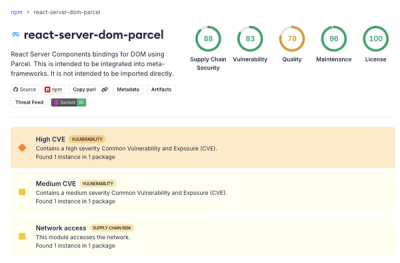
Security News
Deno 2.6 + Socket: Supply Chain Defense In Your CLI
Deno 2.6 introduces deno audit with a new --socket flag that plugs directly into Socket to bring supply chain security checks into the Deno CLI.
@daily-co/react-native-daily-js
Advanced tools
React Native library for making video calls using Daily
The Daily JavaScript library for React Native.
This package introduces some constraints on what OS/SDK versions your project can support:
minSdkVersion >= 24Install react-native-daily-js along with its peer dependencies:
npm i @daily-co/react-native-daily-js @react-native-async-storage/async-storage@^1.15.7 react-native-background-timer@^2.3.1 react-native-get-random-values@^1.9.0
npm i --save-exact @daily-co/react-native-webrtc@124.0.6-daily.1
Then, follow the below steps to set up your native project on each platform. Note that these steps assume you're using a version of React Native that supports autolinking (>= 60).
If your project uses Expo, use the
config-plugin-rn-daily-jsconfiguration package instead of the following steps.
Update the platform in your Podfile, since @daily-co/react-native-webrtc only works on iOS 12 and above:
platform :ios, '12.0'
If you wish to send screen share from iOS, it only works on iOS 14 and above. Therefore, in this case, please switch to using iOS 14.0 instead of iOS 12.0.
Then run:
npx pod-install
Next, you will need to update your project's Info.plist to add three new rows with the following keys:
NSCameraUsageDescriptionNSMicrophoneUsageDescriptionUIBackgroundModesFor the first two key's values, provide user-facing strings explaining why your app is asking for camera and microphone access. Note that the app will simply crash silently without these.
UIBackgroundModes is handled slightly differently and will resolve to an array. For its first item, specify the value voip. This ensures that audio will continue uninterrupted when your app is sent to the background.
To add the new rows through Xcode, open the Info.plist and add the following three rows:
| Key | Type | Value |
|---|---|---|
| Privacy - Camera Usage Description | String | "Daily Playground needs camera access to work" |
| Privacy - Microphone Usage Description | String | "Daily Playground needs microphone access to work" |
| Required background modes | Array | 1 item |
| ---> Item 0 | String | "App provides Voice over IP services" |
If you view the raw file contents of Info.plist, it should look like this:
<dict>
...
<key>NSCameraUsageDescription</key>
<string>Daily Playground needs camera access to work</string>
<key>NSMicrophoneUsageDescription</key>
<string>Daily Playground needs microphone access to work</string>
<key>UIBackgroundModes</key>
<array>
<string>voip</string>
</array>
...
</dict>
To use the screen sharing functionality on iOS, you'll need to do a few manual steps to set up Daily's React Native Screen Share Extension framework (already included in react-native-daily-js).
Please refer to its README for a detailed walkthrough.
Add the following to AndroidManifest.xml:
<uses-permission android:name="android.permission.CAMERA" />
<uses-feature android:name="android.hardware.camera" />
<uses-feature android:name="android.hardware.camera.autofocus"/>
<uses-permission android:name="android.permission.ACCESS_NETWORK_STATE"/>
<uses-permission android:name="android.permission.MODIFY_AUDIO_SETTINGS" />
<uses-permission android:name="android.permission.RECORD_AUDIO" />
<uses-permission android:name="android.permission.WAKE_LOCK" />
<uses-permission android:name="android.permission.WRITE_EXTERNAL_STORAGE"/>
<uses-permission android:name="android.permission.FOREGROUND_SERVICE"/>
<uses-permission android:name="android.permission.FOREGROUND_SERVICE_CAMERA"/>
<uses-permission android:name="android.permission.FOREGROUND_SERVICE_MICROPHONE"/>
<uses-permission android:name="android.permission.FOREGROUND_SERVICE_MEDIA_PROJECTION"/>
<uses-permission android:name="android.permission.POST_NOTIFICATIONS"/>
<application>
// ...
<service android:name="com.daily.reactlibrary.DailyOngoingMeetingForegroundService" android:foregroundServiceType="camera|microphone"/>
</application>
Note: above,
android.permission.FOREGROUND_SERVICE_MEDIA_PROJECTIONis only needed if you wish to do screen sharing.
Update your minSdkVersion in your top-level build.gradle file:
minSdkVersion = 24
(If you run into any issues, refer to Github issues like these, or the react-native-webrtc installation docs, which walk you through a more complicated process. The simpler process laid out above seems to work in a vanilla modern React Native CLI-based setup).
react-native-daily-js is the React Native counterpart to daily-js, and can be used in pretty much the same way to add video calls to your apps. Complete documentation for react-native-daily-js (as well as daily-js) can be found here.
import Daily from '@daily-co/react-native-daily-js';
// ...
// Start joining a call
const call = Daily.createCallObject();
call.join({ url: 'https://your-team.daily.co/allhands' });
// Listen for events signaling changes to participants or their audio or video.
// - 'participant-joined' and 'participant-left' are for remote participants only
// - 'participant-updated' is for the local participant as well as remote participants
const events: DailyEvent[] = [
'participant-joined',
'participant-updated',
'participant-left',
];
for (const event of events) {
call.on(event, () => {
for (const participant of Object.values(call.participants())) {
console.log('---');
console.log(`participant ${participant.user_id}:`);
if (participant.local) {
console.log('is local');
}
if (participant.audio) {
console.log('audio enabled', participant.audioTrack);
}
if (participant.video) {
console.log('video enabled', participant.videoTrack);
}
}
});
}
import { DailyMediaView } from '@daily-co/react-native-daily-js';
// ...
<DailyMediaView
videoTrack={participant.videoTrack}
audioTrack={participant.audioTrack}
mirror={participant.local}
zOrder={participant.local ? 1 : 0}
style={someStyle}
/>;
See this blog post for a more thorough walkthrough of structuring a React video-chat app powered by Daily. It's focused on React web, but most of it should also apply to your React Native app.
Keep in mind that simultaneously displaying videos for numerous participants can use up a lot of your phone's resources. This can make the app run more slowly and use up more of your battery, especially if you're using an older device. For larger meetings, consider only displaying a few videos at a time. In a future release, daily-js's track subscription APIs will be brought over to react-native-daily-js, letting you avoid the network bandwidth cost of receiving video for off-screen participants.
If you'd like to support rotating your phone while in a call, it's recommended that you do not restrict your app's supported orientations (i.e. through Info.plist or AndroidManifest.xml).
If you are restricting your app's supported orientations (to portrait, for example), note that by default you'll end up with somewhat divergent video behavior on iOS and Android whenever you do rotate your phone (to landscape, for example).
On iOS, your captured video will rotate to compensate for the phone's rotation, meaning that:
On Android, your captured video will not rotate to compensate for the phone's rotation, meaning that:
FAQs
React Native library for making video calls using Daily
The npm package @daily-co/react-native-daily-js receives a total of 3,223 weekly downloads. As such, @daily-co/react-native-daily-js popularity was classified as popular.
We found that @daily-co/react-native-daily-js demonstrated a healthy version release cadence and project activity because the last version was released less than a year ago. It has 15 open source maintainers collaborating on the project.
Did you know?

Socket for GitHub automatically highlights issues in each pull request and monitors the health of all your open source dependencies. Discover the contents of your packages and block harmful activity before you install or update your dependencies.

Security News
Deno 2.6 introduces deno audit with a new --socket flag that plugs directly into Socket to bring supply chain security checks into the Deno CLI.

Security News
New DoS and source code exposure bugs in React Server Components and Next.js: what’s affected and how to update safely.

Security News
Socket CEO Feross Aboukhadijeh joins Software Engineering Daily to discuss modern software supply chain attacks and rising AI-driven security risks.